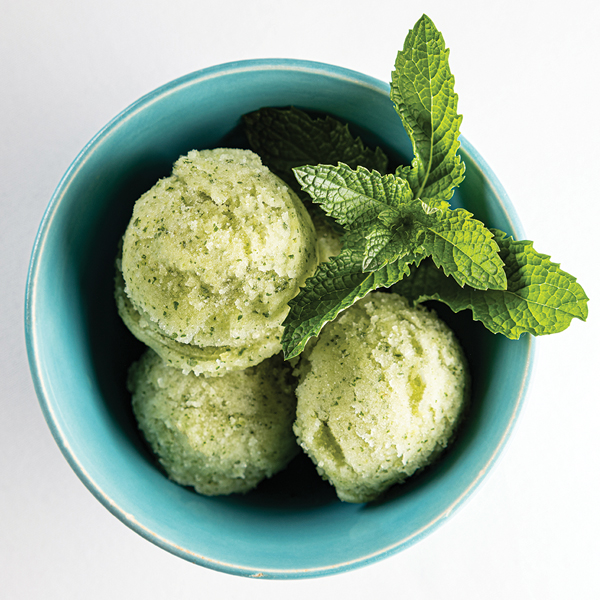
One of the delights of summer is a fresh cucumber, especially if you have grown it yourself. Their seeds germinate rapidly, tend to be prolific, and unlike tomatoes, cucumbers are not attractive to my nemesis—the squirrels. They make me feel like an accomplished gardener!
In the kitchen, cucumbers have a refreshing quality that is welcome in the summer heat, adding a lovely crunch to salads, moisture to lean dishes (like a spicy Laotian larb), and a cooling quality used in condiments that complement piquant dishes in many cultures (raita, tzatziki). And cocktail aficionados would quickly point out their use as a garnish or flavoring makes any boozy summertime libation look somehow healthful. But there is one culinary role for which they are frequently overlooked—and not just by squirrels. That role is dessert.
Granted, cucumbers are not my go-to fruit for a show-stopping conclusion to a summer feast like a layered bread and berry pudding or bubbling peach cobbler, but when you have a garden full of cukes, why not exercise a little creativity. Think of them as a blank canvas awaiting a little tweak here and there to accentuate their dessert-role qualities. Just as at the beginning of a meal, their freshness is restorative, and they have an affinity for citrus and cool herbal flavors like mint and basil that are used in desserts. Combine those qualities with the universal appeal of frozen treats and you have a recipe for sweet summertime success.
Cucumber-Mint Sorbet
Many people are intimidated by the thought of making sorbet, when in actuality the process is quite simple, especially if you have an ice cream freezer or one of the freezing attachments that goes on a standing mixer—you make a base and freeze it (or rather the machine freezes it). For sorbets I have a simple ratio that I use as a starting point. Generally speaking, one quart of fruit juice or fruit purée needs ¾ to one full cup of sugar to achieve a nice freezing consistency. Extremely sweet fruits might need less, startlingly sour ones might need more. Let your taste buds be your guide. (Remember you can always add more sugar, but you can’t take it out.) Using less sugar than that ratio results in a rock-hard popsicle-like consistency—not necessarily a bad thing if you like popsicles. If the sorbet base seems much too sweet, the flavor is easily balanced with a few tablespoons of lime or lemon juice—and always keep in mind that foods don’t taste quite as sweet when they are frozen or at a very low temperature. If you are opposed to using that much sugar, a flavorful alternative to adding the full amount of sugar is adding a tablespoon or two of alcohol. More on that in a bit.
This is how I would make the easiest, fastest, laziest sorbet, perfect for a busy summer when you’re in a hurry and don’t want to fuss around too much in the kitchen: For approximately one quart of sorbet, combine in a blender or the bowl of a food processor 3 cucumbers (any variety, about 2½ pounds, peeled, topped and tailed—that means remove the ends—and cut into chunks), ½ cup sugar, ½ cup honey, the juice of 2 limes (about ¼ cup), and a handful of mint. Purée until smooth, being certain the sugar crystals are mostly dissolved, and taste, adjusting the level of sweetness as necessary (using a bit more sugar or citrus juice). Freeze according to the directions for your ice cream machine. It really couldn’t be simpler.
If you have a little extra time, there are several refinements or variations one could make for a slightly more elegant sorbet, more like one I would serve in a restaurant. The first would be to strain the mixture, which will reduce the amount of fiber in the base, giving the finished sorbet a smoother texture—but you would lose all the health benefits from eating fiber. Another technique for making a more silken texture would be to add a tablespoon or two of alcohol, like vodka (neutral in flavor) or gin (especially one of the cucumber-infused gins like Hendricks) or even tequila or bourbon (like a cucumber margarita or mint julep). The flavor can be tweaked to fit the theme of your meal by changing the herb from mint to basil or cilantro (see Pantry), and the lime could be swapped with lemon. A ginger spirit or an infusion of fresh ginger in the base would take you straight to the tropics. If texture isn’t your concern, or perhaps some of those you are serving don’t wish to consume alcohol, the alcohol could be served alongside for your guests to douse their sorbet as desired. If you don’t have an ice cream freezer, you can freeze the mixture in block form, stirring it occasionally to make a granita, which is essentially a sorbet with really large ice crystals (similar to a Hawaiian ice or snow cone). For a portable popsicle version, be sure to omit the alcohol and reduce the sugar slightly, then freeze in popsicle molds. You could also freeze the base in ice cube trays to use as a garnish for poolside cocktails or purée the cubes in a food processor right before serving for an ad hoc sorbet. The variations are many, and I guarantee a surprise and delight for your guests. So go ahead, try eating your vegetables for dessert, just don’t tell the squirrels what they’re missing.
In Your Pantry: Cooling Herbs
Many summer foods, especially spicy dishes, benefit from the addition of “cool” herbs to help balance flavors and bring a sense of freshness. Mind you, the herbs don’t cancel the heat (and the fiery heat from peppers/capsaicin is what actually cools you off—through perspiration). Instead, the herbs bring equilibrium to the flavors so there is more going on than just the inferno on your tongue. Interestingly, these herbs are interchangeable in many instances and bring a refreshing change to a familiar dish. The next time you need a bit of relief from the heat, give some of these suggestions a try.
Mint
Without a doubt the number one herb when people think of “cool.” There are countless varieties of mint with subtle (and not-so-subtle) variations in flavor, like chocolate, lemon, apple, or ginger, but the two most common mints are spearmint and peppermint. Peppermint has the largest concentration of menthol and other volatile oils and is most easily recognized by purplish stems, deep green leaves, and an intense minty flavor. Spearmint has more spear-shaped leaves, is milder, and is the most versatile and commonly used mint in the kitchen. Although mints are interchangeable in many instances, always taste a bit first to see if it has the exact flavor you are looking for. Try substituting mint for basil in a spicy tomato sauce (or for any dish where you would normally use basil) or in place of or in addition to parsley with seafood (like a spicy marinated fish filet topped with an herb salad or salsa verde).
Basil
For many, basil is the herb of summer. A wide variety of basils, each with a slightly different flavor profile, find their way into cuisines across the globe, frequently with names that indicate their place of origin or cuisine of common usage (like Genovese basil from Italy, Siam Queen from Thailand, or African Blue from, well, Africa). A caprese salad with fresh mozzarella would be impossible without basil but try substituting a non-Italian variety for a change of pace (or even mint!). Many varieties have a sweet anise quality that fans of licorice will welcome in many dishes and drinks. For a little extra sophistication, try basil as an iced tea garnish, or perhaps muddled in your next mojito.
Cilantro
Surely the most controversial of herbs, cilantro (aka green coriander) can be polarizing due to flavors and aromas perceived by some as “soapy,” due in part to both genetics and culture. Haters of cilantro could try substituting mint or Thai basil for the perceived foul herb in many recipes like a summery salsa, whereas lovers of cilantro will find it invigorating in pesto, or many Asian dishes calling for mint. Note that cilantro’s flavor profile is really nothing like basil, mint, or parsley, it just happens to work as a substitute in many instances. (It’s also spectacular in combination with other herbs.)




